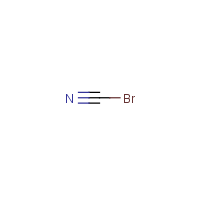Cyanogen bromide
Agent Name
Cyanogen bromide
Alternative Name
Bromine cyanide
CAS Number
506-68-3
Formula
C-Br-N
Major Category
Toxic Gases & Vapors

Synonyms
Bromine cyanide; Bromocyan; Bromocyanide; Bromocyanogen; Bromure de cyanogen [French]; Campilit; Cyanobromide; Cyanogen monobromide; TL 822; Bromocyane; [ChemIDplus] UN1889
Category
Cyanides
Description
Colorless needles or cubes with a penetrating odor; [HSDB] Colorless or white solid; [ICSC] Colorless crystalline solid; [Aldrich MSDS]
Sources/Uses
Used as a parasiticide, a fumigant, a cyaniding reagent to extract gold, and an intermediate in the synthesis of organic chemicals; also used in cellulose technology and textile treatment; [HSDB]
Comments
Highly toxic; [Quick CPC] 230 ppm is a lethal concentration for mice and cats; the same animals are paralyzed by a 3 minute exposure to 70 ppm; Can cause cyanide poisoning; Inhalation in range of 10 ppm can cause pulmonary edema; [HSDB] A lachrymator; [CHEMINFO] Slowly reacts with water/moisture producing hydrogen bromide and hydrogen cyanide; A severe skin, eye, and respiratory tract irritant; Inhalation may cause pulmonary edema; Can be absorbed through skin; May have effects on cellular respiration, causing convulsions, unconsciousness, and respiratory failure; [ICSC] Extremely toxic; The probable oral lethal-dose in humans is less than 5 mg/kg (less than 7 drops for a 70 kg person); [CAMEO] Short-term exposure causes second- and third-degree skin burns and severe eye injury; Vapors cause severe eye and throat irritation (and possibly eye and lung injury) and are intolerable even at low concentrations; [CHRIS] TLV Basis is irritation (eye and upper respiratory tract) and pulmonary edema; In humans, 92 ppm is fatal after 10 minutes; 20 ppm is intolerable after 1 minute; 8 ppm is intolerable after 10 minutes; and 1.4 ppm was the lowest irritant concentration for a 10 minute exposure; [ACGIH]
Biomedical References
Exposure Assessment
Skin Designation (ACGIH)
Insufficient data
Ceiling (ACGIH)
1.3 mg/m3
PEL (OSHA)
5 mg/m3, as CN
MAK
2 mg/m3, as CN, inhalable fraction, as CN
Vapor Pressure
122 mm Hg
Lethal Concentration
LCLo (mouse) = 500 mg/m3/10min
Explanatory Notes
VP from HSDB;
NFPA
will not burn
Adverse Effects
Lachrymator
Yes
Toxic Pneumonitis
Yes
Dermatotoxin
Skin burns
Other Poison
Chemical Asphyxiant
Diseases, Processes, and Activities Linked to This Agent
Diseases
Occupational diseases associated with exposure to this agent:
Processes
Industrial Processes with risk of exposure: